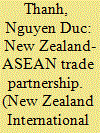|
|
|
Sort Order |
|
|
|
Items / Page
|
|
|
|
|
|
|
| Srl | Item |
| 1 |
ID:
193050


|
|
|
|
|
| Summary/Abstract |
The idea that regional integration is the podium of economic growth dates back a long time. Even now, a plethora of literature confirms a strong and positive link between regional integration and economic growth. However, most of these studies are focused on developed countries. Indeed, literature from developing countries is scant, and that from underdeveloped and landlocked countries like Afghanistan is almost non-existent. In the context of South Asian Free Trade Agreement, this article endeavours to innovatively scrutinize the trends in exports, imports and trade at different industry levels in the trade specialization of Afghanistan. At the harmonized standard 6-digit level of product classification, the study has employed the Lafay Index approach. The study finds that Afghanistan has a greater affinity for resource-intensive manufacturing products and non-fuel primary commodities. The study suggests that Afghanistan should confront issues such as its trade deficit, its dependency on agricultural products for export and the underutilization of its natural resources. The results show that Afghanistan still has a competitive disadvantage over South Asian Association for Regional Cooperation (SAARC) members at different industry levels. The study recommends dealing with problems including technology diffusion, product diversity and quality sophistication at various industrial levels, which restrict a higher degree of trade specialization.
|
|
|
|
|
|
|
|
|
|
|
|
|
|
|
|
| 2 |
ID:
139720


|
|
|
|
|
| Summary/Abstract |
Nguyen Duc Thanh outlines the process by which New Zealand and Vietnam changed from neighbours to strategic partners.
|
|
|
|
|
|
|
|
|
|
|
|
|
|
|
|
| 3 |
ID:
132578


|
|
|
|
|
| Publication |
2014.
|
| Summary/Abstract |
The Association of South East Asian Nations (ASEAN) is among several regional blocs that have received praise from economists for making significant progress towards developing intra- and extra-regional economic relationships. However, opinions differ over the extent of ASEAN's potential for integration. This paper reviews the performance of and prospects for the group's intra- and extra-regional integration. It also reviews the performance of individual members in order to assess whether ASEAN integration could potentially lead to a monetary union in the future. We provide an overview of trade performance and a comparison of three macroeconomic variables: inflation; interest; and exchange rates. We observe that ASEAN members are in a favourable position to form a strong economic zone in the near future, but adopting a common monetary policy is less plausible.
|
|
|
|
|
|
|
|
|
|
|
|
|
|
|
|
| 4 |
ID:
167016


|
|
|
|
|
| Summary/Abstract |
The paper investigates the dynamic relationship between renewable energy usage and trade performance in sub-Saharan Africa (SSA), while considering the conditioning role of corruption control, regulatory quality, and the private sector access to finance. Focusing on 42 SSA countries for the period 2004–2016, and engaging the System generalized method of moments (GMM) technique for its estimation, this study found a negative relationship between renewable energy usage and the indicators of trade performance. However, with corruption control, improved regulatory framework, and better finance for the private sector, there are potentials for a positive net impact of renewable energy usage on manufacturing export. For renewable energy and total trade nexus, we find that improved regulatory framework, and better finance for the private sector are important conditioning structures. These findings are significant because they highlight the different important structures of SSA countries that improves the effect of renewable energy use on trade outcomes. For instance, the consideration of the financial, institutional and regulatory frameworks in SSA countries in conditioning the renewable energy-trade nexus stipulates a clear policy pathway for countries in this region as the debate for transition to the use of renewable energy progresses.
|
|
|
|
|
|
|
|
|
|
|
|
|
|
|
|
| 5 |
ID:
155802


|
|
|
|
|
| Summary/Abstract |
There have been trade interactions between Africa and some Asian countries, specifically India, a South–South trade relation, which are accompanied with outcomes that are based on output, macroeconomic stability and compliant with the agreements reached at different points in time. This study investigates the effects of Africa’s trade agreements with India on Africa’s exports. The findings suggest that there are potentials for Africa’s exports in India. The trade agreements in Africa−India trade relations were marginally trade-enhancing, while Indian high tariffs did not debar Africa’s exports access. However, the non-tariff barriers were more pronounced than the tariff barriers.
|
|
|
|
|
|
|
|
|
|
|
|
|
|
|
|
|
|
|
|
|